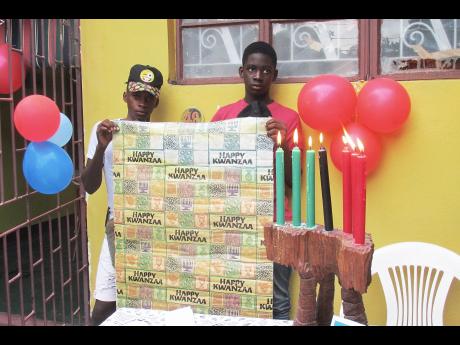Celebrating Kwanzaa
Queen Mother Miriamne Samad was born in Harlem, New York, is a Garveyite, and has evolved into a black pride/power advocate and activist. She moved to Jamaica in 1975 with her Garveyite husband Abdul Samad who was born here.
Queen Mother brought back the teachings of Garvey back to Garvey's native land which she fell in love with simply because Garvey was born here. Another thing she brought with her was the seven-day celebration of Kwanzaa, which she said at one time attracted approximately 100 people.
On January 1, thought the number of celebrants was significantly fewer than 100 Queen Mother Samad hosted a Kwanzaa dinner at her St Andrew home. It consisted of the lighting of the seven candles of Zwanza, an engaging presentation on black pride and self-acceptance by a Garveyite called Jawari, and of course, a feast on food and refreshments provided by Moby Dick Restaurant from downtown Kingston.
The concept of Zwanzaa appeals to Samad because it goes hand in hand with the ideals and philosophy of National Hero Marcus Mosiah Garvey for whom Samad has never ceased to express her love.
Zwanzaa was started in December 1966 as a cultural, and not religious, holiday by Maulana Karenga, a professor and department chair at California State University Long Beach. He said "the celebration of Kwanzaa is about embracing ethical principles and values, so the goodness of the world can be shared and enjoyed by us and everyone".
It was established mainly for African Americans to reconnect with their roots and heritage,
and that was why an African word was selected for the holidays that last from December 26 to January 1. Also spelt Zwanza, and pronounced Kwahn-zuh, it originated from a Swahili phrase, 'matundayazwanza', which means 'first fruits'.
The celebrations are underpinned by seven principles, also known as the Nguzo Saba. They are unity, self-determination, collective responsibility, cooperative economics, purpose, creativity and faith.
Unity (Umoja) builds a community that holds together. Self-determination (Kujichagulia) is speaking for yourself and making choices that benefit the community. Uujamaa (cooperative economics) supports businesses that care about the community.
Nia (a sense of purpose) sets goals that benefit the community. Kuuma (creativity) makes the community better and more beautiful. Imani (faith) is the belief that a better world can be created for communities now and in the future
There are also seven symbols of Zwanzaa. Celebrants drink from the unity cup (Kikombe cha umoja) in honour of their African ancestors. The Kinara (seven-candle holder) symbolises stalks of corn that branch off to form new stalks. Fruits, nuts and vegetables that remind celebrants of the harvest fruits that nourish the people of Africa are represented by the Mazao.
The Zwanzaa symbols themselves are arranged on the Mkeka, a mat made of straw or African cloth, depicting the foundation upon which communities are built. Traditionally, an ear of corn (Vibunzi) is placed on to the Mkeke for each child present. Children also get educational and cultural gifts on January 1, the last day of the festivities.
The seven candles of Kwanza are collectively called Mishumaasaba. Each represents a day and is lit on that particular day. They are arranged in the Kinara, three red ones on the left, three green ones on the right, and a black one in the centre.
Red represents the blood that is shed in the struggle for freedom, black is for the colour of the people, and green symbolises the fertile land of Africa. They are the same colours as the Universal Negro Improvement Association, established by Marcus Garvey.
On January 1, the candles were lit by Winsome Moffatt, while her daughter Jordaine Moffat read the meaning of each as she did so.


